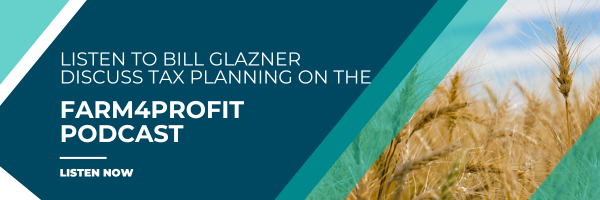Maximize Tax Benefits in Ag: Take Advantage of Bonus Depreciation & Section 179
Unlocking Tax Benefits for Farmers with Bonus Depreciation & Section 179
The agriculture industry is a competitive and ever-evolving sector. To remain competitive, many farmers are taking advantage of bonus depreciation and Section 179. These tax incentives allow farmers to purchase new equipment and machinery while receiving tax savings.
Bonus depreciation is a tax incentive that allows farmers to claim a deduction on their income tax returns for the full cost of certain eligible assets. This deduction is equal to 100% of the cost of the asset, and can be claimed in the year the asset was purchased. This means that farmers can save a significant amount on their taxes and reinvest the funds into their business.
Example: If a farmer purchases a tractor for $80,000 and is placed in service in 2022, they would be able to deduct the entire $80,000 in 2022. Placed in service means the farmer would have the equipment in hand and it would be ready to use. However, most new equipment can take a while to be delivered, so if the farmer ordered a new combine and paid for it in 2022 but did not receive the combine until 2023, they would not be able to take the 100% bonus depreciation deduction on it in 2022.
Bonus depreciation for qualified property is automatically taken unless you elect out of it. When you elect out of bonus, it is for the entire class. For example, say you purchased a trailer, drill and tractor in 2022, and they are all seven-year assets. You cannot choose to elect out of bonus on one of the assets, such as the tractor. The election would be made for all three of the assets in the seven-year class.
Bonus Depreciation Decreases
In 2023, bonus depreciation is expected to begin decreasing and will no longer be 100%. The following shows the phase-down amounts:
- 80% for property that is placed in service in 2023
- 60% for property that is placed in service in 2024
- 40% for property that is placed in service in 2025
- 20% for property that is placed in service in 2026
In addition to bonus depreciation, Section 179 also provides tax incentives to farmers. This allows farmers to deduct the cost of certain assets from their taxes up to a certain dollar amount. This tax incentive allows farmers to purchase larger items such as tractors, combines and other large equipment without paying full price upfront. This can be especially beneficial for farmers looking to upgrade their equipment but don’t have the funds available.
Example: A farmer purchased a new farm pickup and a new trailer for $65,000 and $15,000, respectively. They are five-year assets, but the farmer can take section 179 on just the trailer and take regular depreciation on the farm pickup. He can take any amount of section 179 on the asset up to the full $15,000 cost.
The section 179 deduction is limited to taxpayers’ taxable income from all business activities. In other words, it cannot be utilized to create a loss. This differs from bonus depreciation because when taking bonus, it can create a loss on the business. The maximum deduction you can have for 2022 is $1,080,000. The limit is reduced by $1 for every $1 over the $2,700,000 investment limit. Section 179 can be used on farm machinery, breeding livestock and grain bins, but it is not allowed for multi-purpose farm buildings.
Overall, bonus depreciation and Section 179 provide important tax incentives to farmers. These incentives can be used to save money on taxes and reinvest the funds into the business. By taking advantage of these incentives, farmers can stay competitive and remain profitable in an ever-evolving industry. Farmers with questions about their specific situation can reach out to Adams Brown’s agriculture team.


